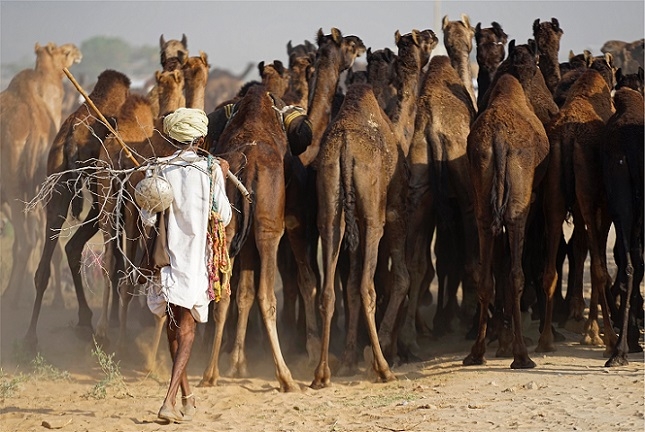
Author explores the nomadic culture and shared history of this frontier region with reference to the Thar by taking a close look at representative communities of pastoralists, the Raikas, bards, the Charans, and musicians, the Langas and the Manganiars.
Yashaswini Chandra
‘. . . O, sweet [bird] Kurjan
You are like my sister
Lower your wings
And come close to me
Allow me to write my grievances on your wings
And my greetings on your beak.
Hasten, sweet bird
Go to my dear one.’
(Excerpt from the folk song Kurjan, as translated in Kothari 1972)
To the Sufi poet Khwaja Farid, the Cholistan desert—a part of the Thar/ Great Indian Desert—was no wasteland. He describes it as ‘a site of wildness and madness . . . the place of lovers . . . a place of joy and gladness’ (as quoted in Shackle 2007:94). For better or for worse, this desert landscape is the leitmotif in the rich traditions of folk tales and folk songs from the region.
Now divided between India and Pakistan, the Thar Desert was historically at the heart of the western frontier of South Asia. This western frontier region stretched from the doabs of Punjab, a patchwork of green and gold fields of wheat, maize, cane sugar and mustard intersected by rivers, to the crusty white salt marshlands of Kutch. It included the arid landscapes of Rajasthan and Sindh. From east to west, Rajasthan consists of rocky scrublands that briefly arch into the Aravalli hills and then dissolve into a golden sea of sand dunes that stretch into Sindh. The western frontier consisted of cultures at crossroads, rather than at the ‘mainstream’ of India, that developed along distinctive lines based on a strong tradition of vernacular languages and folk cultures. For the longest time, before the Partition of India and before colonial intervention, the ‘wanderings’ of agro-pastoralists, traders, musicians, bards, ascetics, soldiers and adventurers defined the region.
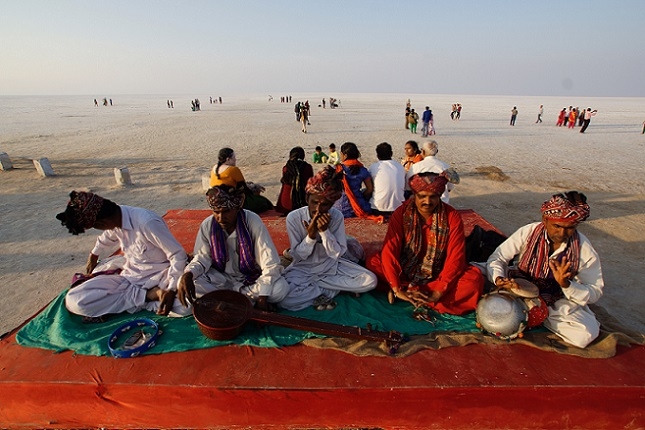
Shared experiences are manifest in tales of romance, valour and faith. The culture of wandering is highlighted in the epic romance of Dhola-Maru, sung as a ballad by the Langa and Manganiar musicians. A prince of Narvar, Dhola, and a princess of Pugal in Marwar, Maruni, Marwan or Maru, are married as children, expected to be united as adults. However, the marriage is all but forgotten until Maru grows up, dreams about Dhola and is gripped with desire for him. Dhola, in the meanwhile, may well have moved on with a second wife, Malvani, a princess of Malwa, who is determined to sabotage any attempts by Maru and her parents to send word to Dhola. ‘Desert wanderers’, a horse-trader, Dhadhi musicians, Charan bards and a yogi, serve as intermediaries and abettors until Dhola and Maru are finally reunited.
Musicians from Pugal reach Narvar and literally sing Maru’s praises besides Dhola’s palace. ‘Their tale made ardent desire spring up in Dhola’s heart’ (Vaudeville 1996:309). He becomes desperate to travel to Pugal to claim Maru but convincing Malvani to let him go on a journey is easier said than done. He first tries to cajole her to let him travel and try his fortune, promising to lavish her with gifts:
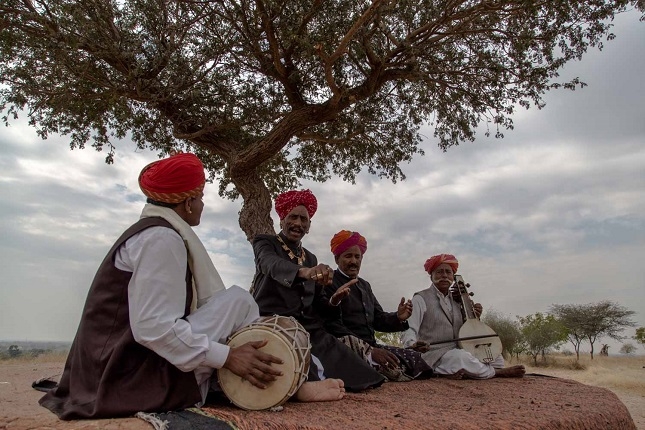
If you let me, I will go and serve the king of Idar [in Gujarat], there I will have jewels carved for you, and I will send them to you . . . I want to go to Multan, the bowmen there are highly paid: O gazelle-eyed lady, if you will consent with a smile, I will bring you back a herd of Tukhar [or Central Asian] horses! . . . The camels of Kacch [or Kutch], with two humps, cover [a long distance] in half an hour: O Fair One, listen, if you say yes with a smile, I will go and fetch you one.
But Malvani is unmoved and Dhola is forced to tell her truth, hardly designed to lower her resistance. Dhola is finally able to wear her down and flee to Pugal on a special camel. Malvani is left swooning and pining. In any case, she is not the last of the couple’s problems. After a delirious reunion in Pugal, on their journey back to Narvar, Maru is bitten by a snake but then revived by a yogi. They are then chased by a band of ‘desert prowlers’ or plundering horsemen after their chief, Umar Sumra, eyes Maru, until a bard convinces Umar Sumra to leave the couple alone. They finally make it to Narvar, where Maru is installed as Dhola’s favourite wife. An interesting afterword is the rivalry between the two wives that takes the form of the two disparaging each other’s homelands. Malvani heaps disdain on the barren landscape of Marwar. Indeed, in a precis version of the ballad sung by Langa musicians in western Rajasthan to date, Dhola himself asks Maru how a woman as beautiful as her can be born in Marwar, the land of thorny trees—khejdi, rohido and kumatiyo—and prickly grass. However, he defends Marwar to Malvani and, thus, Maru is a metaphor for the unlikely beauty of the desert.
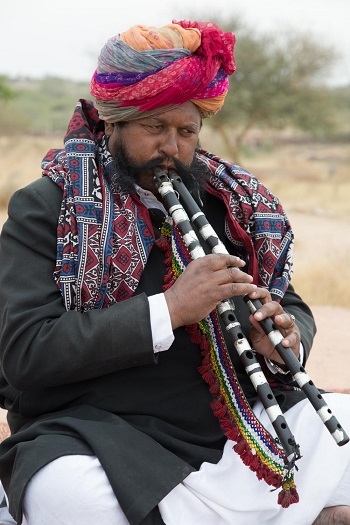
Separation and longing are recurrent themes in romances from a region where lovers were often parted as the men had to travel. In Vijaydan Detha’s iconic retelling of a Rajasthan folk tale, Duvidha, the decision of the trader’s son to go on an extended business trip without a thought to his new bride forms the plot device. He leaves a vacuum that is filled by a ghost assuming his appearance, with the knowledge of the wife. In the epic romance of Jasma Odan, Jasma exchanges the life of a princess for a laborer’s when she chooses to marry into the Od community, rejecting all others. The Ods used to dig wells and tanks, and it was the one community where the men and the women worked alongside each other.
In this article, I explore the nomadic culture and shared history of this frontier region with reference to the Thar by taking a close look at representative communities of pastoralists, the Raikas, bards, the Charans, and musicians, the Langas and the Manganiars. Although the focus is on these particular communities, others are referenced throughout in text and photos.
***
Pastoralists from the Raika, Gujar, Jat, Sindhi Sipahi and Rajput communities lived rough lives herding their camels (in the case of the Raikas) and sheep through the Thar in search of seasonal pastures, travelling as far as Gujarat, Malwa in western-central India, Sindh and Punjab. In Vijaydan Detha’s Duvidha, the eponymous ‘dilemma’ is resolved by a wise shepherd where an entire village fails, his earthy wisdom surely honed by living by his wits close to nature.
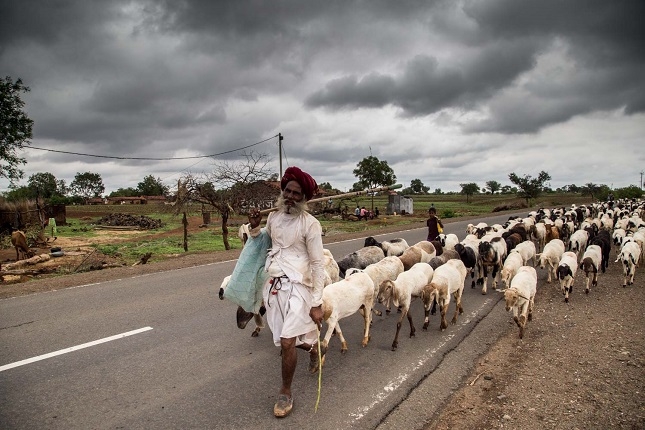
The Raikas are ‘the pastoralists par excellence’ (Kavoori 1999:5), as well as specialist camel breeders. To date, a typical sight of western Rajasthan is the wiry figure of the Raika man wearing a thick twisted turban, holding a staff in one hand, herding his camels and sheep through the arid landscape. The even more startling sight is of a Raika dhang or caravan on the move, including entire families along with their hordes of camels and sheep. Such was the centrality of the camel in local imagination that there is an entire genre of Rajasthani folksongs dedicated to the camel, kariyo, as well as bardic literature in praise of camels, besides lions, horses and buffaloes, known as birdalo.
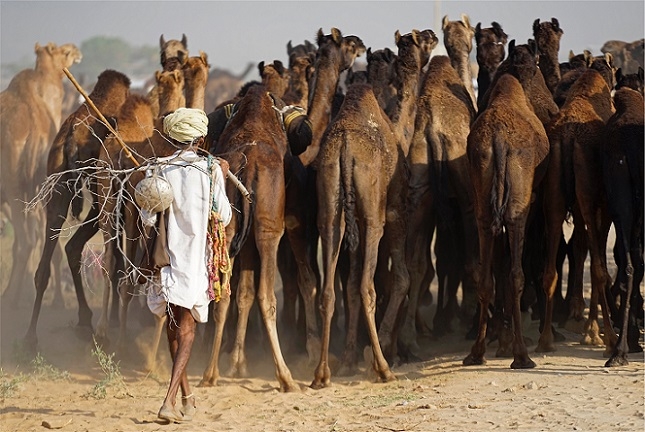
Both myth and reality relegate the Raikas to the margins of local history and society. Called Shiva’s bhuts (ghosts), after he stumbled on their progenitor, Chaamad, sleeping by a funeral pyre, they are considered vagabonds who roam the wilderness looking for grazing. They are also called Rabari, those that have ‘strayed from course’ (raah bari). Their fringe position is summed up in a popular saying in Marwar: ‘Raah bahare Raika, gaon bahare ghar’, just as the Raika is outside of the mainstream, his house is outside the village.
The Raikas themselves consider their traditional occupation of camel-rearing a divine calling. They believe that they were created by Shiva to look after camels after the animal was created by Parvati. Their understanding of their place within the larger history of Rajasthan is seen in the local oral epic ‘Pabuji’. Pabuji is a folk deity, with a following mainly among the Raikas. His following among the Rajputs is based more on caste affinity as he was a Rathore Rajput. To that extent, Pabuji is primarily a subaltern deity, an apotheosised bhumia. In one of Rajasthan’s best-known epics, a colorful cast of tribal Bhil archers, Raika messengers and a Charan woman rally around the eponymous hero, as he takes on a cow-killing ruler of Patan, the demon-king of Lanka and Rajput adversaries for the sakes of his sister, niece, Bhil allies and Charan ward. He not only protects cattle but also introduces camels in Marwar. In a spectacular feat of livestock rustling, Pabuji travels to Lanka, vanquishes no less an adversary than Ravana, and steals his camels. Importantly, a Raika, Harmal, does the recce and lays the groundwork for Papuji’s success in Lanka. He is in turn rewarded by Pabuji with half the contingent of camels. ‘Pabuji’ is an incredible tale full of such colourful details as Pabuji’s mother, originally a nymph, turning into a tigress and suckling her baby, the princess Phulvanti pining in a desert fortress for the footloose Pabuji, the burly Dhemo tucking his tired horse under his arm and running to catch up with the rest of Pabuji’s party, and Dhemo, also a practical joker, hiding the Charan Deval’s favourite one-eyed bull-calf in his opium box.
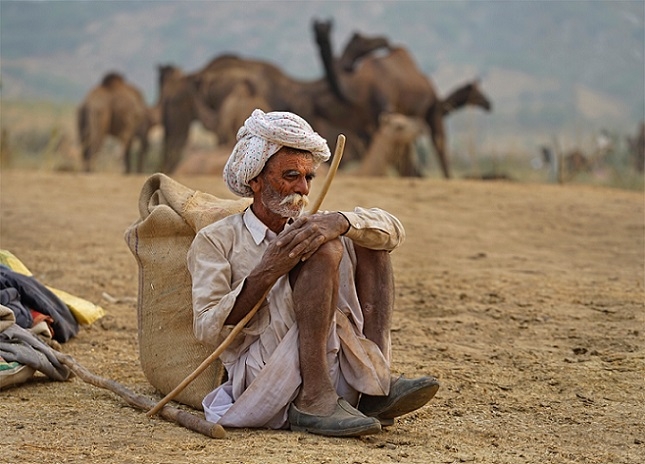
The same inter-caste alliances that are reflected in the epic have led to the deification of Pabuji and kept the epic alive. Composed by Charan bards, it is sung-recited by Nayak or desert Bhil bhopas (priests) for largely Raika patrons/followers. The singing-recitation of the epic was once believed to have such miraculous powers that sick camels were said to have been cured by it. The epic is sung by bhopas either at shrines dedicated to Pabuji, depicted on stone steles as riding his mare, Kesar Kalami, or in association with a phad. A long cloth painted by a caste of artists, the Joshi-Chhipas, with episodes from the epic, the phad is packed with lively depictions of the extensive cast of characters—dominated by hefty depictions of a turbaned, mustachioed Pabuji, often astride his finely caparisoned horse—in a sequence that only the bhopas can interpret. It is treated as a sacred object until the paintings are well and truly faded. The bhopa and his assistant/s, often his wife, the bhopi, put on a night-long show that includes singing, playing the fiddle-like ravanhatha and dancing to narrate different episodes from the phad. The poignant notes of the ravanhatha played by the bhopa, the measured jingling of the ghungroos (bells) on the bow and on his ankles, and his full-throttle voice fill the air in an evocative performance. The singing-recitation of the entire epic typically takes seven nights. The unfurled phad performs the role of a mobile temple that the peripatetic bhopas may set up anywhere on their travels, following the trail of their nomadic herdsmen patrons. Pabuji is also invoked by the Raikas in the tale’s simplest form in a group-singing practice by called jhurava. The nomadic herdsmen probably started singing the epic about their patron deity as a way of keeping their spirits up on their long and arduous journeys across the Thar and beyond.
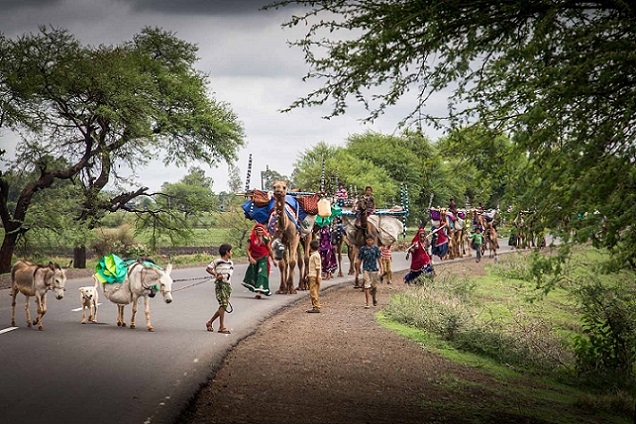
***
The Thar made the most of its central location on the western frontier. Trade directed towards Sindh, connecting India to Central Asia by land routes and to West Asia by sea, passed through it. Imagine caravans of camels, donkeys and Kankrej oxen trudging through the desert, transporting all kinds of goods, from textiles, salt and opium, to horses. They make their way through undulating sand dunes, in the red and yellow shades of the desert soils, past rocky little hills. They pause at wells by the shade of straggly trees. By night, the same landscape becomes moon- and star-lit silver, and the same hills appear dark looming shapes. Suddenly the caravans are swarmed by gangs of bandits armed with swords and matchlocks. They are confronted by escorts of caravan protectors. Under normal circumstances, one would imagine that these guards would be the first to get attacked. Except that they are no ordinary escorts. They are the Charans.
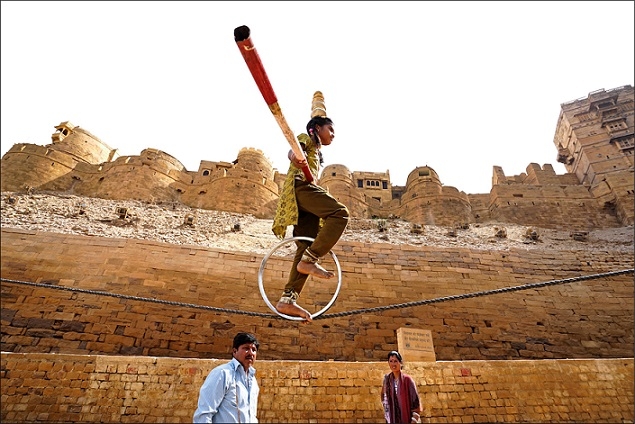
Far from assailing the Charans, who threaten to kill themselves in a terrible practice known as taga and, thus, lay a curse on the raiders, the bandits back off leaving the caravans untouched. What was so special about the Charans that hardened caravan raiders were terrified of having Charan blood on their hands? It is because this unique community of Rajasthan and Gujarat had made a reputation for themselves as deviputras or ‘sons of the goddesses’. In this self-projection project, they were aided by the ruling elite, mainly the Rajputs, who adopted the extensive pantheon of Charan goddesses as their kuladevis or patron deities, and the Charans as their bards. This link between the Rajputs and the Charans is reflected in epics such as ‘Pabuji’, where Pabuji’s Charan ward is supposed to be an incarnation of the goddess Durga. The Bhats performed the role of the genealogists of the Rajputs, while the Charans composed panegyrics and eulogized their patrons. It was a defining feature of social life in the Thar that all communities, not just the ruling castes, had genealogists and musicians attached to them, as is discussed in the next section. This in itself is reflective of a nomadic culture, where histories had to be preserved orally.
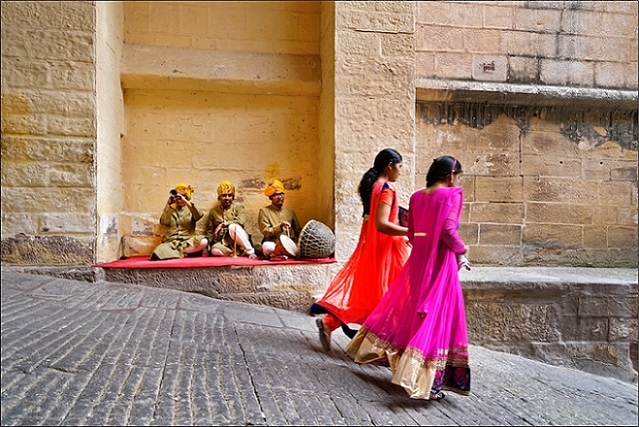
Charan bards brought the same force to their words as they did to their personality when they committed taga. The Rajput would ride into battle accompanied by a Charan, his poetry ringing in his ears. Although there is evidence of the relationship between the two communities souring under colonial intervention, previously they had shared a symbiotic alliance. The Charans acted as arbitrators and guarantors in dealings and agreements between Rajputs, once again resorting to taga if one party did not keep his end of the bargain. Such glorification of death worked in a society dominated by a Rajput community that set great store by dying in the battlefield for Rajput men and by self-immolation for their women. The Charans were after all the repositories of Rajput narratives of valour and honor. In return for their services, the Charans received generous grants of land and gifts of livestock, as well as all kinds of privileges, from dining and consuming opium with their patrons to being spared from paying various taxes.
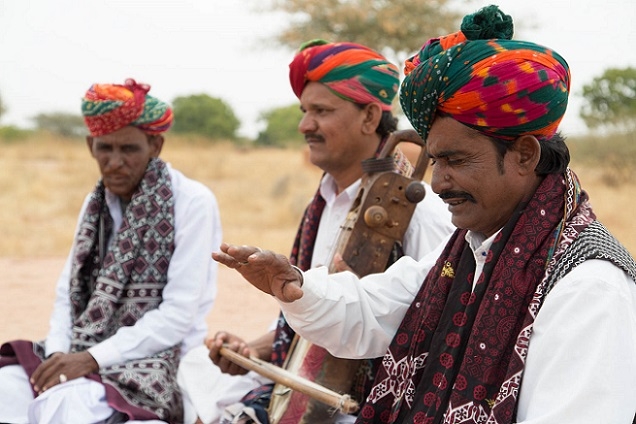
Hence, the Charans were entrenched in two of the most powerful networks of the Thar: trade and the feudal order. This is notwithstanding their humble beginnings as probably pastoralists. According to their myth of origin, they had an origin comparable to the Raika’s, since they were created by Shiva to look after cattle. This is reiterated in the etymology of their name—‘grazier’. But in any case, in the Thar, communities had to combine various sources of livelihood to survive. Droughts and famines were so commonplace that there is an entire corpus of bardic outpourings of grief. There are plenty of instances of famines leading to entire villages uprooting and resettling in different parts within the western frontier and beyond. The Charans happened to be a typically versatile community, starting out as agro-pastoralists but going on to take on highly specialized roles. It is no wonder that, in the process of serving as caravan escorts, they gained such deep knowledge of the desert that many grew in trade to the extent of becoming traders in their own right and commanding caravans of their own. Who on earth would dare attack a Charan caravan?
Click here for reading Full Article
_______________
Yashaswini Chandra is a historian specializing in the arts and cultures of Northern India, with special interest in the Western Himalayas and Rajasthan. She has a PhD from the Department of the History of Art at the School of Oriental and African Studies (SOAS), University of London.
Courtesy: Sahapedia